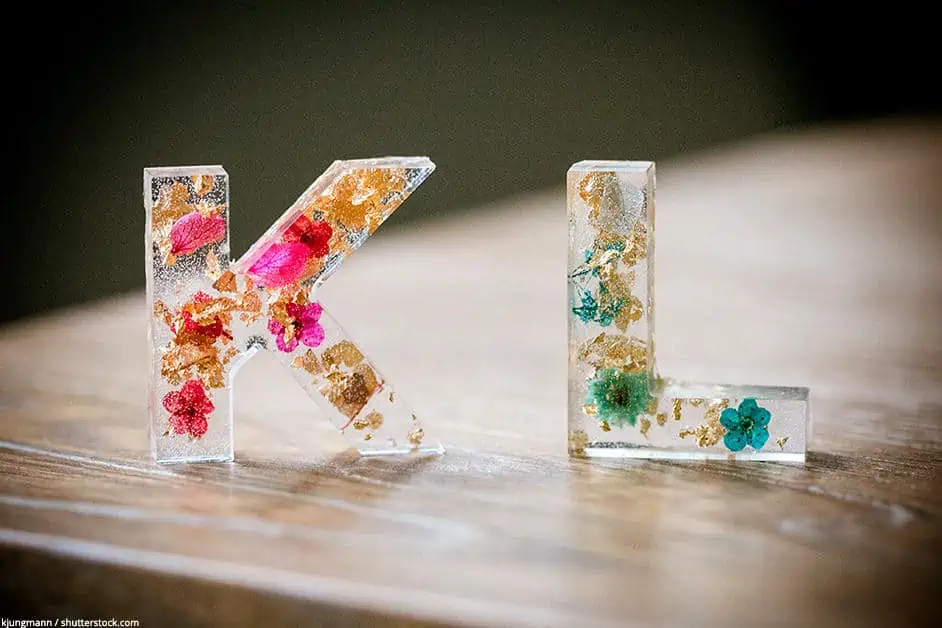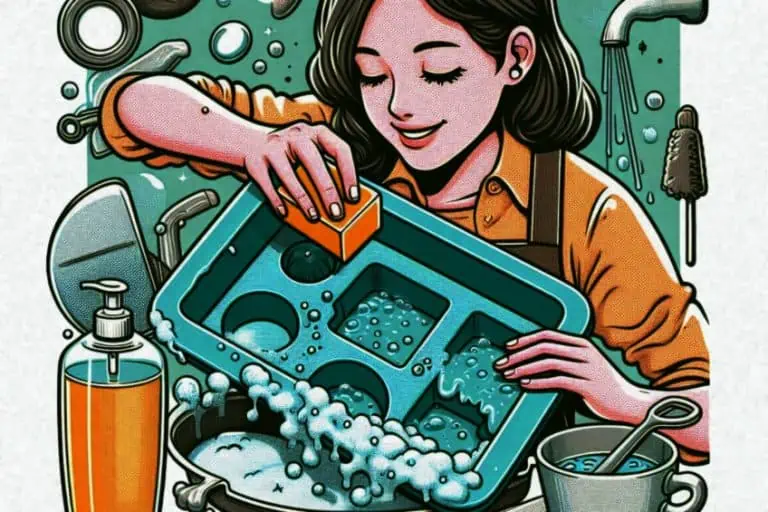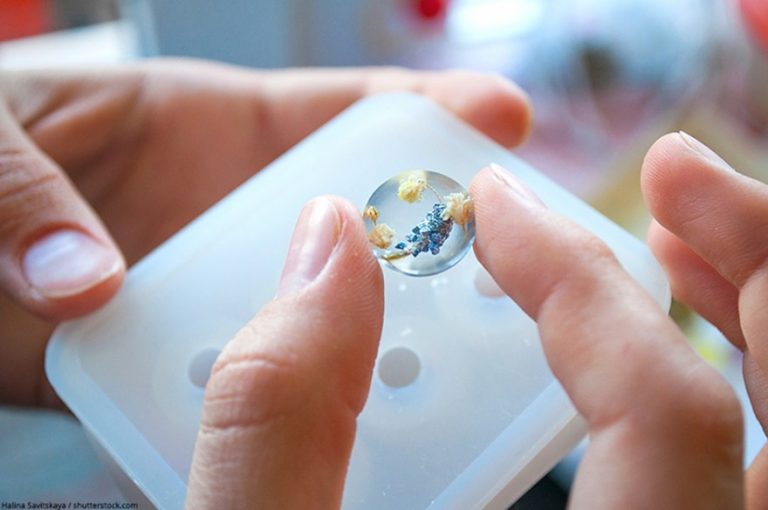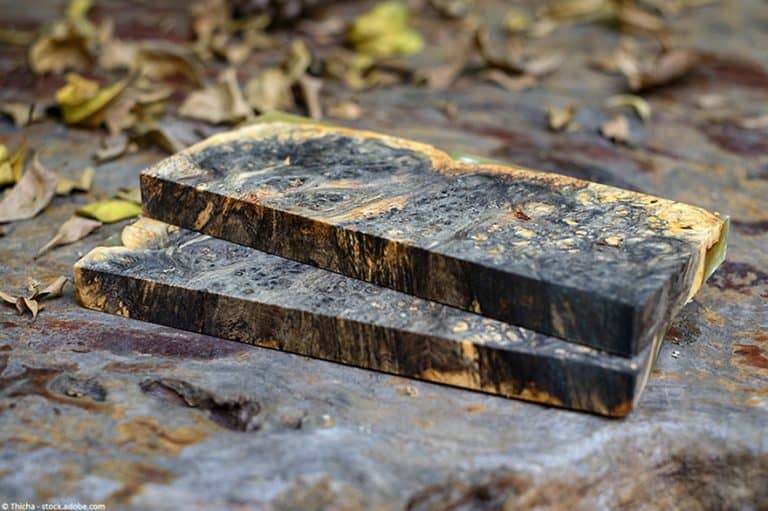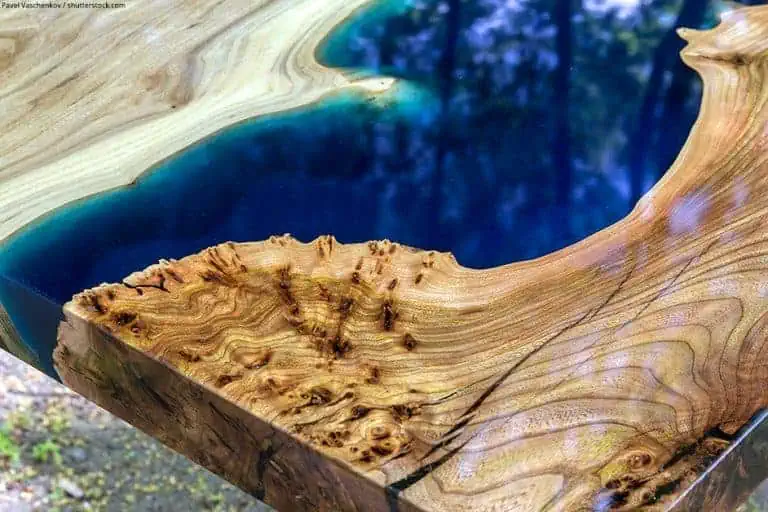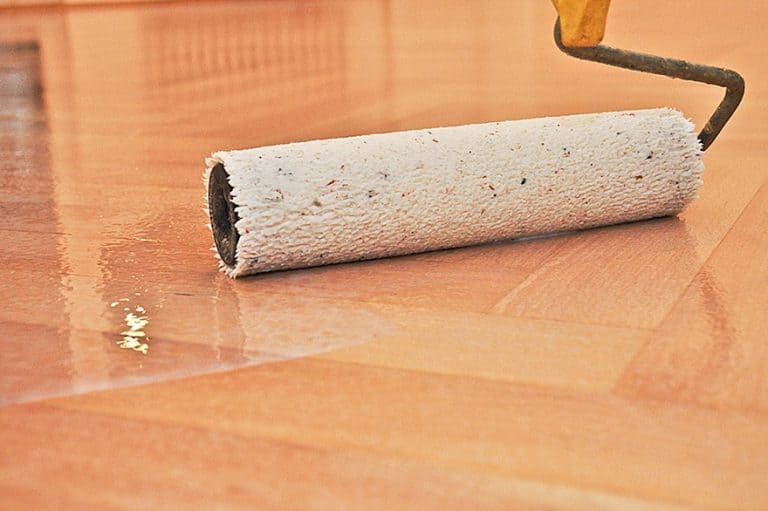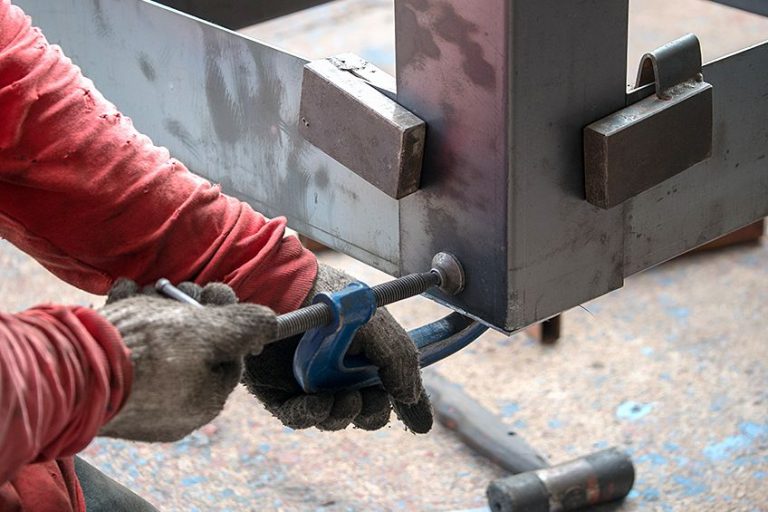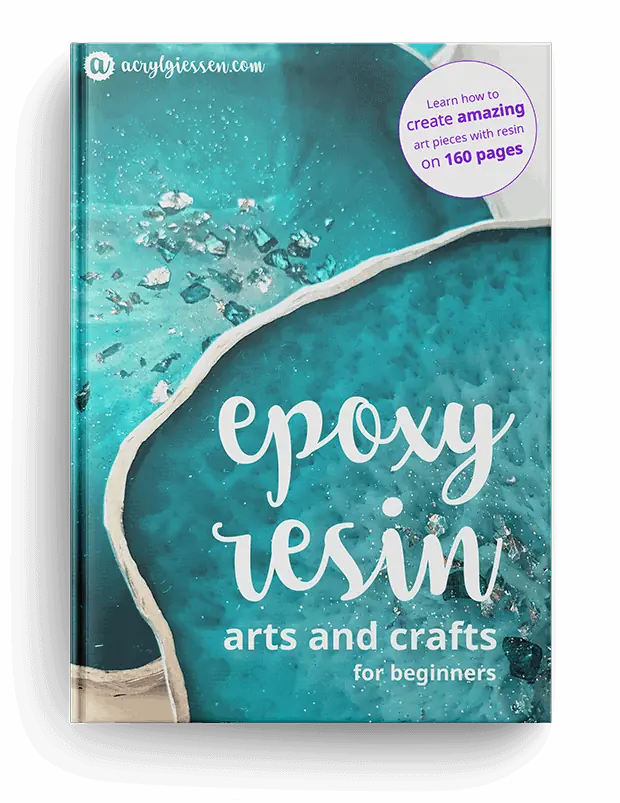Preserving Flowers in Resin – How to Preserve Flowers in Resin
This post may contain affiliate links. We may earn a small commission from purchases made through them, at no additional cost to you.
Resin is a very versatile substance and has many uses, but for the DIY enthusiast embedding items in resin is always popular. You can embed small trinkets, coins, stones, beads, bottle caps and, of course, flowers. Flowers are delicate, beautiful, and perfect to embed in resin, preserving their beauty. In this article, we will explain in detail how to go about preserving flowers in resin.
Table of Contents
- 1 Different Applications for Dried Flowers
- 2 Materials Required for Preserving Flowers in Resin
- 3 Real Dried Flowers bought online
- 4 Artificial Flowers
- 5 Dry your own flowers
- 6 Dry your Flowers yourself – Step by Step Instructions
- 7 How to Preserve Flowers in Resin – Tutorial
- 8 Tips and Tricks
- 9 How to Preserve Fresh Flowers in Resin
- 10 Roses in Clear Resin
Different Applications for Dried Flowers
There are numerous applications for dried flowers such as:
- Used in various teas.
- Can be sealed in a sachet and will keep your dresser drawers smelling fresh.
- Dried flowers can be molded into the wax to make candles.
- Often used in beauty care products like body scrubs etc.
- Dried flowers can also be used to make birthday cards and special gifts.
However, in this article, we will be concentrating on how to preserve flowers in resin. Here are some of the different applications for dried flowers in resin. We will also be dealing with the question; do you have to dry flowers before putting them in resin?
Wedding Bouquets
Your wedding day is a special occasion, which takes a lot of time and preparation as well as money. This is especially true for your flower bouquet; it is a great pity to see all of that just wilt away within a few weeks after your wedding. A popular idea is for you to preserve your wedding bouquet in resin. This will last for many years and whenever you look at it, all the special memories will come flooding back.
Botanical Coasters
You can preserve dried flowers in resin this way, and these coasters will add a beautiful touch to your decor. It is also a good idea to use as a gift for a kitchen tea or Mother’s Day, or even for someone’s birthday.
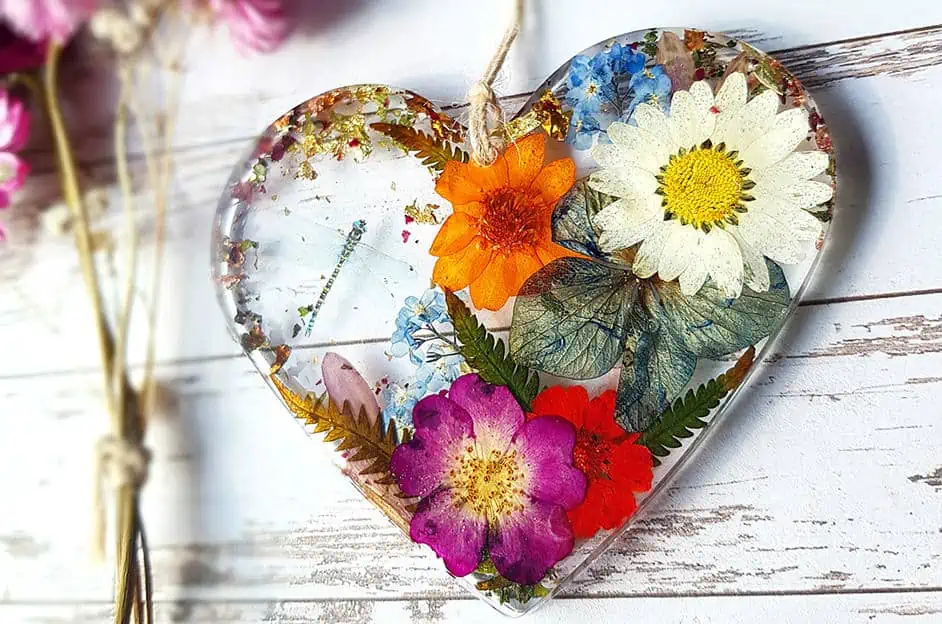
Cell Phone Cover
Your cell phone is always nearby, and you handle it more than any other object during the day. Want to pretty it up? Why not place some flowers in resin on the back cover.
Jewelry
When it comes to resin jewelry, there are so many different applications you can use with dried flowers. Preserving flowers in the resin can be done with necklaces, bracelets, pendants, rings and so much more.
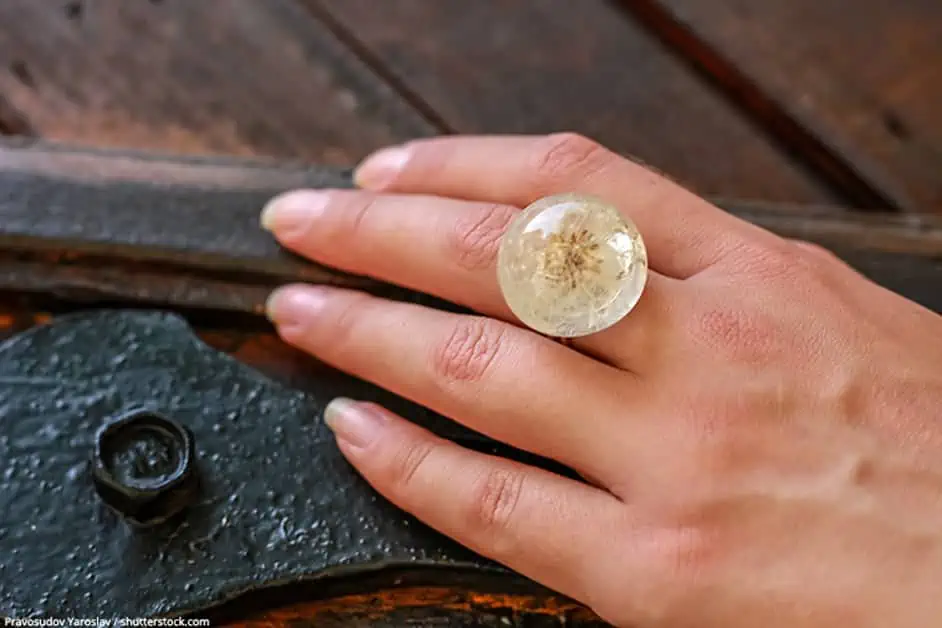
Flowerpot Holders
Instead of having plain plastic flower pots around the house, you can make them look so much more attractive by encasing them with dried flowers in resin.
Picture Stands
Do you have family pictures just lying in a draw or cupboard? Why not create a picture stand with dried flowers in resin, your memories can be displayed in your living room for all to see and enjoy. If you prefer to hang your pictures on the wall, you can make your own picture frame with resin flowers.
Paper Weights, Wind Chimes or Sun-Catchers
I have seen many amazing paperweights made from different types of materials and embedded items. Here is an opportunity to make your own unique paperweights with flowers in resin. You can also use flowers in resin to create amazing wind chimes and sun-catchers.
Sure, there are many more applications for dried resin flowers but let us now have a look at what you require to create flowers in resin. Are you ready to take up the challenge and create that special something?
Materials Required for Preserving Flowers in Resin
If you have decided to use used dried flowers for your project and want to know how to preserve the flowers in resin, then these are the materials you will need to complete your project.
Best Resin for Preserving Flowers
There are many different brands of resin on the market, which one you choose is important to the success of your project. Many artists use the following:
For smaller molds with optimal hardness and almost no air bubbles:
- Specifically designed for art projects, excellent color stability
- Very easy to use with 1 : 1 mixing ratio, 100% solids, hard-shell finish
- High gloss and crystal clear, your all-seal solution, excellent air release
For bigger molds without producing too much heat when curing and crystal clear look:
- Custom formula causes minimal bubbles and avoids craters
- Epoxy when used and cured correctly it is safe with a low odor
- Mixes well with mica pigment powders and cures crystal clear
You are looking for resin products that have a high-gloss lasting finish, have a low odor, are non-flammable and non-toxic. Also, a resin that is self-levelling and cures fully within 72 hours is perfect for these types of projects.
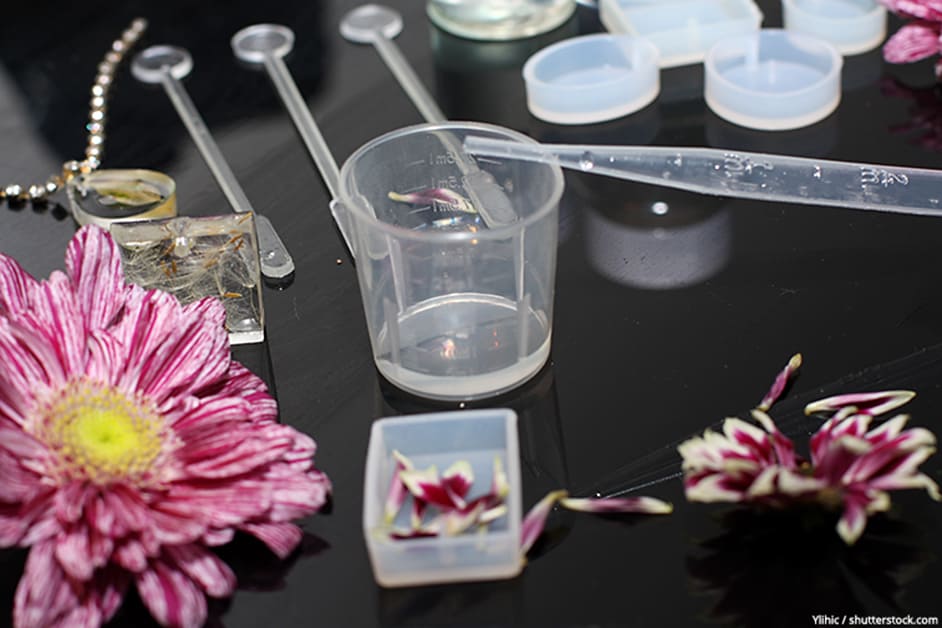
Molds
Depending on what you want to do, you will need silicone molds. You can purchase these in many different sizes and shapes.
- High-quality 10pcs Coasters Resin Molds Set
- Includes 4 pcs round coaster molds and 4 pcs square silicone molds
- Made of high-quality silicone, very flexible and durable
- Includes everything needed for resin casting, making it ideal for beginners
- The kit provides high-quality epoxy resin that cures to a crystal clear ensuring professional-looking results
- This kit is designed to be user-friendly, enabling beginners to create a wide range of resin crafts with ease
Craft Sticks or Popsicle Sticks
These are used to mix the resin with.
Toothpicks
These come in very handy to pop the air bubbles that form after pouring the resin.
Heat Gun or Hair Dryer
Sometimes it is necessary to use these tools to get rid of the bubbles in your resin.
Two Temp Settings 750ᵒF & 1000ᵒF
Use the heat gun to remove air bubbles from your epoxy
- You can also use the air flow to customize your artwork as long as the resin is flowing
Sandpaper
To finish your resin flowers off properly, you will need some fine sandpaper. The grit size you will need is 150; 200; 400; 1000 and 3000-grit.
Respirator, Safety Goggles, and Nitrile Gloves
This equipment is essential for your safety and protection when working with resin.
- Half-mask multi-purpose respirator
- Patented nose-bridge design for optimum fit and seal
- lightweight design with long-life cartridges and hygiene cover
Plastic Drop Cloth
This cloth is there to catch any of the resin you may spill and saves you a lot of time in cleaning up afterward.
Different kinds of dried Flowers
Two kinds of flowers are available for preserving in resin and they are Real Flowers and Artificial Flowers.
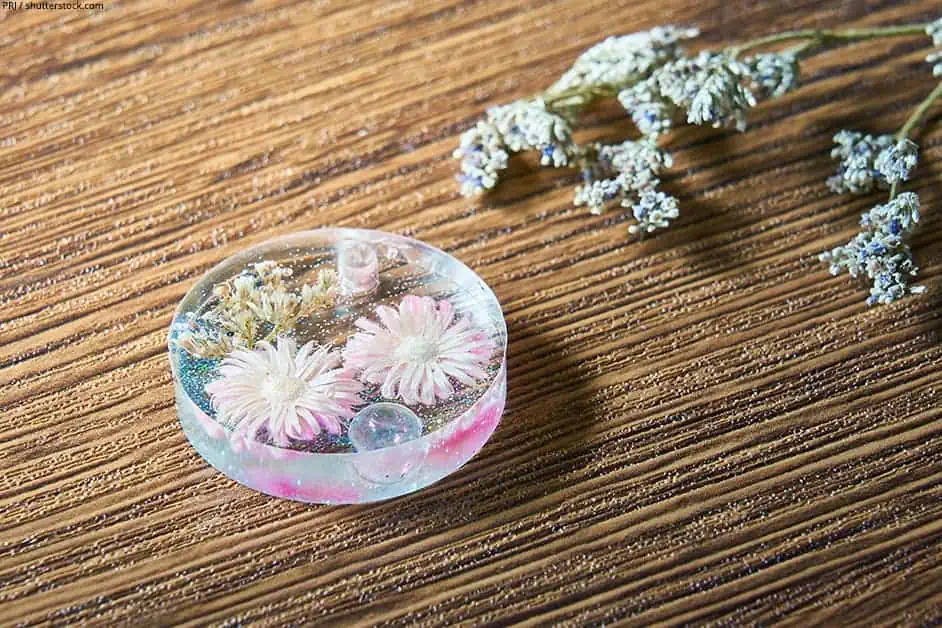
Real Dried Flowers bought online
Real Dried Flowers are available at your local florist where you will be able to choose what type of flowers you want and the quantity you need. Then there is the option for buying your real dried flowers online, which are available at Amazon, Etsy and many more stockists. However, when you buy online, they usually come in bunches of various kinds of flowers. Some of the flowers you may not make use of, you will also have to take the quantities supplied to you.
Artificial Flowers
Artificial Flowers are also available from your local florist, you can also purchase them from your local house and home retail stores. Here again, you will be able to buy exactly what you need and in the quantities you require. Again, the artificial flowers are also available online from Amazon, Etsy, and others. Here again, you will have to take the quantities offered, and you will not be able to choose one or two separately.
Dry your own flowers
This is a far better solution than buying. You can pick your own fresh flowers and you can choose exactly the type and quantities you need. All you need to do is take them home, dry them out and you are ready to create your own resin flowers project.

Dry your Flowers yourself – Step by Step Instructions
Drying flowers and leaves to preserve them is an old technique, and it is effective in preserving their beauty for years to come. Let us now consider the various techniques you can make use of when you want to dry your own flowers:
Pressing the Flowers in a Book
This technique for drying flowers can be done in two different ways; using a large heavy book or a flower press. This method will flatten your flowers which will allow you to frame them and hang them on your wall. Flowers with thin petals are best suited for this application like Gladiolus, Delphiniums, Pansies, Poppies, Geraniums and much more.
This is how it is done:
- You need to go and pick the flowers you want to press and ensure that you pick them after the dew has dried. You also need to decide if you want to include the leaves and if you want the flower that has fully bloomed or is still in its bud stage.
- Make sure you get them pressed quickly before they have a chance to wilt. Now place the flowers in your book between two sheets of absorbent paper to protect the pages of your book or between two smooth sheets if you are using a flower press.
- All types of flowers take different times to dry but to be safe leave them to dry for 3 to 4 weeks. It is better to leave them for too long then you will be sure they are dry otherwise they will be damaged.
- Your pressed flowers are now ready for you to use on gift cards, wedding invitations, for decorating cakes, decorating candles, in frames as a picture and many many more uses
Pros
- This is an easy and cheap method to use for drying flowers.
- It does not require any special ingredients or complicated instructions.
- Leaves your flowers beautiful and flat.
- Can be used for many craft projects, as well as being a fun activity for kids to do.
Cons
- The process can take up to 4 weeks to complete.
- Unfortunately, the full beauty of the colors and vibrancy are not always retained with your flowers.
- This method makes your flowers brittle and delicate, they can easily break if not handled with care.
- Flowers are flat
- If moisture gets in, the flowers can go moldy.
You can also use parchment paper for this method instead of a book. Simply place your flowers between two layers of parchment and then put something heavy on top.
Drying in Silica Gel
This technique for drying flowers is quick and effective. The first step is to select the flowers you want to dry. The best flowers to use with this method are delicate flowers like lilies. It is also a good idea to pick your flowers before they are fully open.
Next, you need to choose what type of material you want to use to dry your flowers with. There are several options available for you:
- Silica Gel or silica sand: This is the fastest method and the material is easy to buy from your local supply stores. It is also fairly cheap and can be used over and over again.
- Borax and White Corn Starch: This is very cheap, easy to use and readily available. Just mix 1 part of Borax with 6 parts of Corn Starch.
- Fine Sand: This is a much slower method, which is cheap to do and readily available. The idea is not to cover the flowers with the sand, instead, lay them on top of the sand so that the sand can support them. Now leave them and allow the air to slowly dry them.
You need to select a suitable container to use that can take the whole flower with its stem. If you use silica gel you need to select a container that can seal airtight. For the Borax and Sand, you just need to select a container that is strong enough.
Place the flowers into the selected container and follow these steps:
- Pour some of the silica gel or sand into the container to measure about 1 or 2 inches (2,5 or 5 cm) deep.
- Next, place your flowers into the silica so that they stand upright.
- Some flowers like snapdragons and delphiniums dry better when they are lying flat.
- You can now pour more of the silica over the flowers until they are completely covered.
- You need to place the container in a dry and warm area and leave them to dry.
- Silica Gel dries flowers faster in 2 to 4 days. Keep a check on your silica and see if it turns pink, this means it has absorbed all the moisture it can take.
- Borax, on the other hand, will take about 5 to 14 days to dry the flowers.
- Sand can take much longer, usually up to 21 days.
- It is now time to remove the dried flowers from the material you used. Clean them off using a soft small brush, and once cleaned use some hairspray to keep them from breaking up.
Pros
- This is one of the quickest methods for drying flowers but will still take a couple of days
- With this method, you can preserve the whole flower
- It is a very cheap and easy technique
- You will not lose the amazing colors of your flowers
Cons
- If you pour too much material over the flowers or you pour it too quickly, you could damage the flowers.
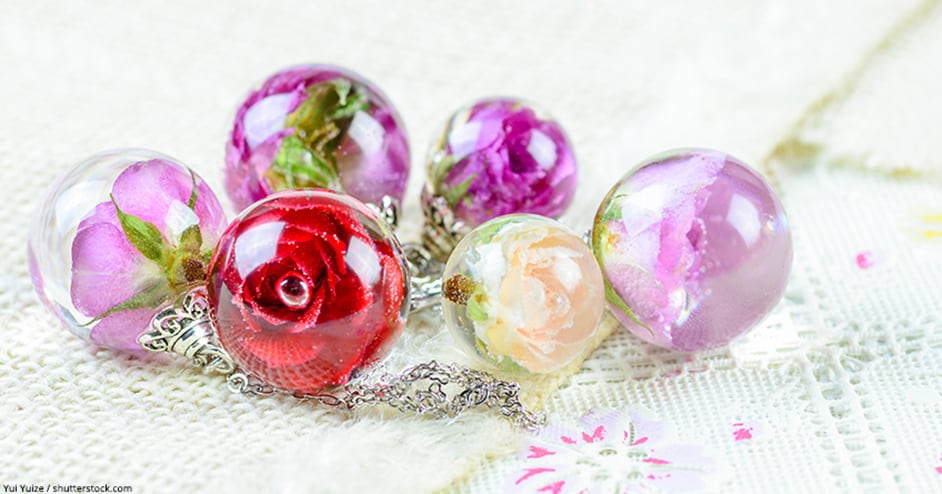
Hanging it up to dry
This method is the easiest, as all you have to is hang the flowers out and leave them to dry. The type of flowers most suited for this method is whole bouquets, roses that are very robust and smaller types of flowers that are long-lasting, such as lavender.
Here is a step by step process for you to follow:
- First, remove the leaves off the stems and cut the stems to about 6 inches long. If you want to keep the vibrant colors of your flowers, you should start the drying process as soon as possible.
- Next, take the flowers and tie a rubber band or piece of string around the stem of each flower or the stems of all the flowers in your bouquet.
- Your flowers are now ready to be hung out to dry. You can attach the string or rubber bands to a coat hanger or rod and hang them upside down to dry. It is preferable to find a dark place where the air is dry and has good ventilation.
- You need to dry the flowers for around 3 weeks, to ensure they are completely dry. Then remove them and spray them with unscented hairspray, which helps keep them protected.
Pros
- With this method, you can preserve the complete flower and not just the petals
- You will be able to preserve the complete bouquet without separating the flowers.
- You will not lose the amazing colors of your flowers.
- Unlike fresh flowers, dried flowers can last for many years.
- This method is very easy and costs you nothing.
Cons
- Your flowers will only completely dry out after three to four weeks.
- If you don’t start with the process as soon as possible, you will be in danger of losing the vibrant colors.
- After the drying process, the flowers will be stiff and can break easily.
- Some flowers like roses, for example, can shrink in size slightly.
- You should not air dry Orchids, as they take a long time to dry and lose their color.
Microwave Flower Press
You will need 2 flat microwave-safe ceramic plates, some coffee filters, and a microwave.
- Your materials need to be placed in this order, plate face-up, a coffee filter, your flowers, another coffee filter and the last plate face-up.
- Place in the microwave for only one minute and then remove.
- Check to see how dry your flowers are, replace the coffee filters and microwave again as before.
- Continue with this process until you are satisfied your flowers are completely dry.
Pros
- It is one of the quickest methods for drying flowers, as they dry within minutes and you do not have to wait days or weeks.
Cons
- As all flowers do not dry at the same temperature, there is the possibility that you may overheat your flowers and destroy them.
Microwave with Silica Gel
Like the method above, it is meant for the impatient pressers that want results in a hurry. Both techniques are perfectly safe, as the microwave radiates heat, which heats the moisture in the flowers and allows the vapor to escape, thereby drying out your flowers. The flowers most suited for this type of drying are roses, daisies and most white and pale-colored flowers.
This method is very quick and all you will need is a microwave-safe container, some silica gel, and a microwave. The silica gel is used to keep the shape of your flowers, you can use it more than once and is obtainable form any craft store.
- Look for a microwave-safe container that is large enough to take your flowers, but not too big that it won’t fit into your microwave.
- Pour the silica gel into the container to cover the bottom, about an inch or two thick. Next, arrange your flowers on top of the gel, blossom-up and then pour some more silica gel on top. Pour carefully so as not to damage the flower, pour until you have covered the petals completely.
- Put the container, without the lid, into the microwave and set it to the desired temperature. Not all flowers dry at the same time, so you need to use a trial and error system here to achieve the best result. Set your microwave for two heat levels above defrosting for about two to five minutes. Check it from time to time and increase the heat if needed.
- When you are satisfied your flowers are completely dry, open the door of the microwave and cover the container with the lid straight away. After you have removed the container from the microwave open the lid slightly in one corner and leave it for about 24 hours.
- Remove the petals from the gel and very carefully clean the gel off of the flowers by using a fine brush, then spray them with an acrylic spray to preserve them for longer.
The Pros and Cons are the same as for the Microwave Flower Press. We should warn you about the Silicone gel get extremely hot, do not handle the gel or the container until it has cooled.
How to Preserve Flowers in Resin – Tutorial
We now come to the part where we will take you step by step through how to preserve flowers in resin. Casting or embedding various items in resin is a technique used which can preserve items for an exceptionally long time. We have already seen what type of materials you will need and also how to buy your dried flowers or how to dry them yourself. Now, we will see how to cast flowers in resin.
Mixing the Resin
First, get everything you will need ready and close by. Be sure you protect yourself properly by wearing nitrile gloves, a respirator or mask and safety goggles.
Take your plastic or paper cups and start to mix the resin using your craft or popsicle sticks. Make sure you read the manufactures instructions properly. The casting resin usually comes in two parts and is mixed in a 1:1 ratio. You have 1-part resin added to 1-part hardener. However, some brands use a 2:1 ratio, which means 2-part resins to 1-part hardener. So, make sure you mix exactly as the instructions tell you.
If you mix incorrectly, you will have a brittle resin casting, or it will remain sticky and will not fully cure. Make sure you mix it slowly and thoroughly, some say about 200 revolutions, while others say for at least for 3 to 4 minutes.
We recommend you use a clear resin, so you can see your flowers clearly after it has cured. Next, leave it to stand for a minute or two so that the bubbles can rise to the top. If the bubbles do not disappear, use your toothpick, or heat gun to remove them.
In doubt as to how much resin to mix? Here is an indication of what you can use: If your container measures 12 x 12 inches and you pour a standard first layer of 1/8 inch, then you will require 2.5 ounces of resin and 2.5 ounces of hardener.
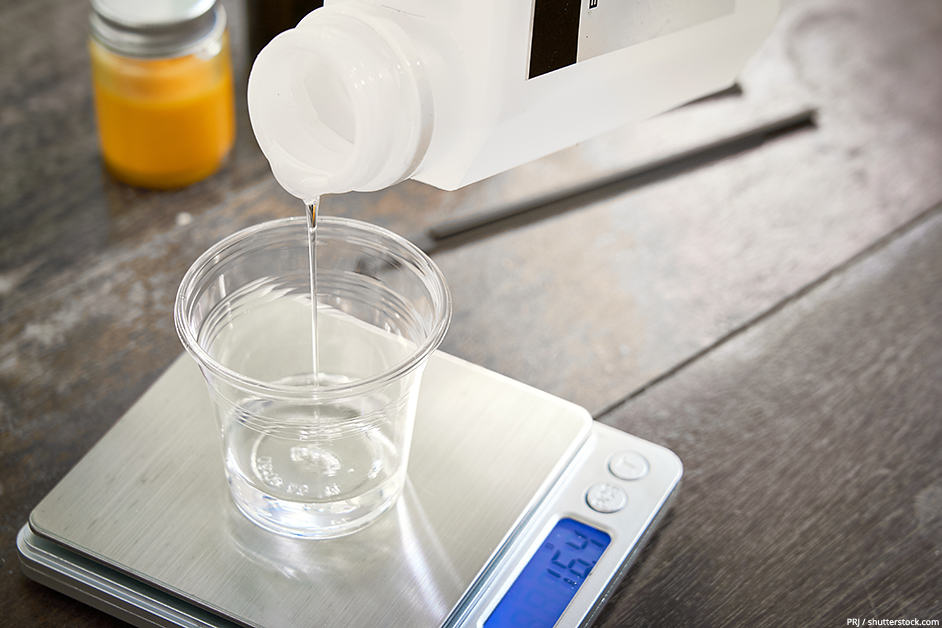
Pour the base and place the flowers
Now it is time for you to pour your resin into the mold. You need to keep in mind that the resin you mixed will start to cure between 12 and up to 48 hours, which gives you enough time to work.
Take the size and shape of the mold you have chosen, preferably silicon, and make sure you clean it properly. You do not want any particles of dust or other objects in it. Lay the mold flat on your work surface, making sure it is level. Pour the first layer of resin in the bottom of your mold and make sure it covers the whole area.

Depending on how deep your mold is or how thick you want your finished product, we suggest you pour more than one layer. This will also ensure your flowers will be in the middle of the resin, providing a floating effect. Make sure you remove any air bubbles at this stage by using a heat gun or toothpicks.
You are now ready to place your flowers in the resin. Before you do, make sure they are completely dry, as moisture will cause them to go brown. Lay them gently down on top of the resin and by using your craft or popsicle stick, arrange them how you want to give them that 3-D effect. We also suggest you lay your flowers face down, as the bottom of your mold will become the front side of your finished product. This step needs to be followed as your flowers are lighter than the resin.
Make sure that no air bubbles have formed under the petals of the flower, if they have, now is the time to remove them. Let the first layer cure but keep an eye on your flowers, ensure they stay in place and do not shift.

Remember, always read the manufactures instructions, as certain resin brands require you to pour your second layer before the first layer has cured properly. This allows both layers to bond properly.
Casting the Mold
When you are satisfied the flowers are properly set and in place, it is time to cast the top layer. You need to cover the flowers completely and fill the mold with the resin.

Removing Air Bubbles
Make sure any air bubbles that have formed are removed with a toothpick. Some artists have mastered the technique of using a drinking straw and blowing softly over the resin, in this way the bubbles are removed.
Curing and Finishing
Allow the resin to cure properly, this will differ for all resins so follow the manufactures instructions to be sure. Most resins will dry to the touch within 24 hours, but to completely cure it will take between 48 and 72 hours.
After the resin has properly cured, you can remove it from your mold. At this stage, if you find that it is still slightly flexible, level it out properly and give it more time to become hard and properly cured.
Now comes the cleaning part and finishing your resin flower off. At the back or along the edges, you resin flower may be slightly rough. By using fine sandpaper these marks can easily be removed. If you have used a silicone mold, there should be no need for any sanding down, as your product should be perfectly smooth and shiny. We do recommend that flowers in resin are kept out of direct sunlight, as the sun may cause the flowers to lose their radiance.

Tips and Tricks
Here are some tips and tricks that may help if you are tackling how to preserve flowers in resin for the first time. The flowers referred to below are a variety of colors, delicate blooms, small flowers, bright-colored and white flowers, but you can use whatever flowers you like.
Is it better to seal the Flowers before casting in Resin?
Yes, if you give your flowers a protective coat before you cast them, it will stop the resin from causing any change to your flowers.
Remember, flowers are organic substances and can trap air bubbles and by sealing them you prevent the bubbles from forming in the resin. Sealing your flowers also keeps them from crumbling and keeps them in a more rigid shape. This type of process has different results when applied to dried flowers as opposed to fresh flowers.
There appear to be two methods used for this process and we will show you how below:
The Glue Sealing Method
This simple, you just need to cover them with some clear glue or ModPodge. As both of these products can be fairly thick, you need to thin them by adding some water. Make a solution of thinned glue and dip the flowers into the solution, or you can use a fine soft brush and carefully brush the glue over both sides of the flowers. This method is easy to do and it keeps your flowers in their original shape, however, some of the flowers may lose their bright colors.
Results for fresh Flowers:
- Lilacs: The glue changed the color of the flowers to brown.
- Cherry Blossoms: The glue changed the color of the flowers to gray.
- Common Daisies: Because the petals are so thin they kept sticking together and the color changed.
- Japanese maple: The thinner parts of the petals curled slightly.
- Buttercups: The petals appeared to repel the glue and formed a lump in one place.
- Daisies: The glue changed the color of the petals to green.
Results for dried Flowers:
- Lilacs: The glue changed parts of the color of the flowers.
- Cherry Blossoms: The glue caused the petals to crumble and stick together.
- Common Daisies: All the petals stuck to each other.
- Japanese maple: There appeared to be no change at all.
- Buttercups: All the petals crumbled slightly.
- Daisies: There appeared to be no change at all.
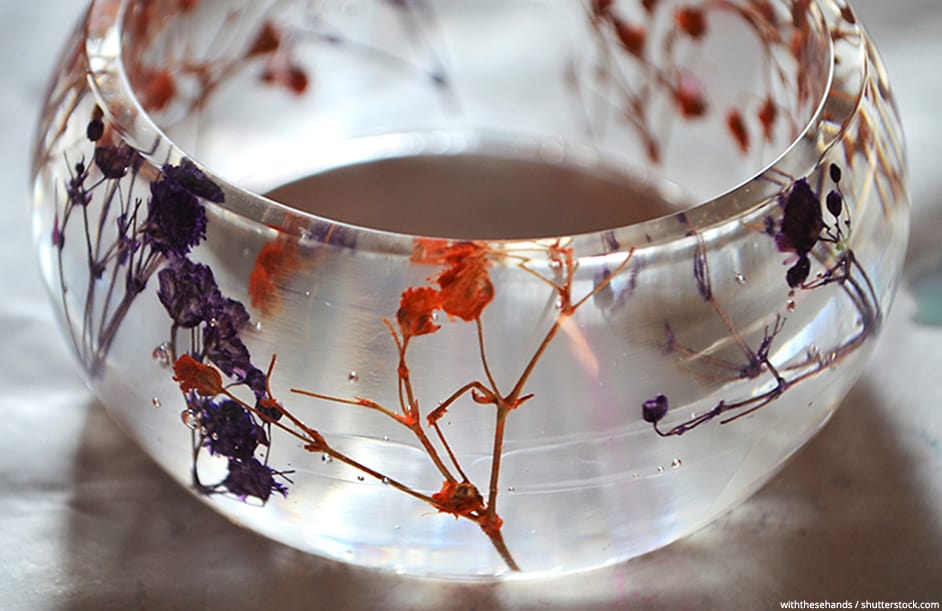
The Hairspray Method
Another method to seal your flowers is to spray them on both sides with hairspray, or any lacquer spray. This method is easy to do and it keeps your flowers in their original shape, but it is a very sticky and messy job and the flowers need several layers.
Results for fresh Flowers:
- Lilacs: The spray discolored the flowers and left them in one horrible brown blob
- Cherry Blossoms: The spray made the petals transparent and they stuck to each other.
- Common Daisies: The petals turned green and stuck to each other.
- Japanese maple: The leaves turned slightly transparent.
- Buttercups: The petals appeared to crumble slightly.
- Daisies: The petals turned slightly transparent.
Results for Dried Flowers:
- Lilacs: The color of the flowers never changed but it lost volume.
- Cherry Blossoms: The flowers became very fragile.
- Common Daisies: The petals became very thin.
- Japanese maple: They turned out good.
- Buttercups: They turned out flat but very nice.
- Daisies: They looked very nice.
You may be wondering if you have to seal dry flowers before putting them in resin. Please bear in mind a lot depends on the type of resin you use, and some types of flowers need a sealing coat, or the flowers will discolor. You might have to take your flowers one at a time and test them with each method before you put them in the resin.
- Lilacs: The best method to use is dried flowers.
- Cherry Blossoms: These flowers work best when fresh and sealed using the glue method.
- Common Daisies: The fresh method was found to be the best for these types of flowers.
- Japanese maple: All the methods used turned out well but the dried flower method was the best.
- Buttercups: The best method for these flowers was the dried flowers.
- Daisies: Both the glue and the spray changed the colors of the flowers, so the best method to use would be the dried flower method.
There is another method for sealing your flowers. You can use a plastic laminating pouch or some clear tape and sandwich the flowers between the two surfaces. Next, we will be looking at can fresh flowers go in resin?
How to Preserve Fresh Flowers in Resin
Do you have to dry flowers before putting them in resin? To be able to preserve fresh flowers, we need to learn how to cast fresh flowers in resin. Fresh flowers always have the most amazing colors and beauty, you want to make them last forever. The first thing we need to learn when working with fresh flowers is to try and keep them as fresh as possible for as long as possible. To do this you need to keep them as cool as you can, they can last in your fridge for a couple of hours. You can also just make sure they are in a cool and dry space.
In this section of the article, we will try and teach you how to cast fresh flowers in resin. The first question that comes to mind is, can fresh flowers go in resin? The answer to this question is no, as fresh flowers are organic and if you fail to dry them completely before you put them into the resin, they will turn brown and rot.
The solution to this problem is to dry your flowers first. The other solution is to seal your flowers before you put them into the resin. It is so much easier just to put your fresh flowers into the resin mold and fill it with your resin. However, if you do this then the results will be as follows:
- Lilacs: The resin discolored the flowers and turned them brown.
- Cherry Blossoms: All the petals of the flowers shrunk in size.
- Common Daisies: All the petals lost their color and became transparent.
- Japanese maple: The area where the flowers were thinner began to curl.
- Buttercups: Most of the pollen from the flowers leaked into the resin.
- Daisies: Became transparent.
You can find more information on instructables.com
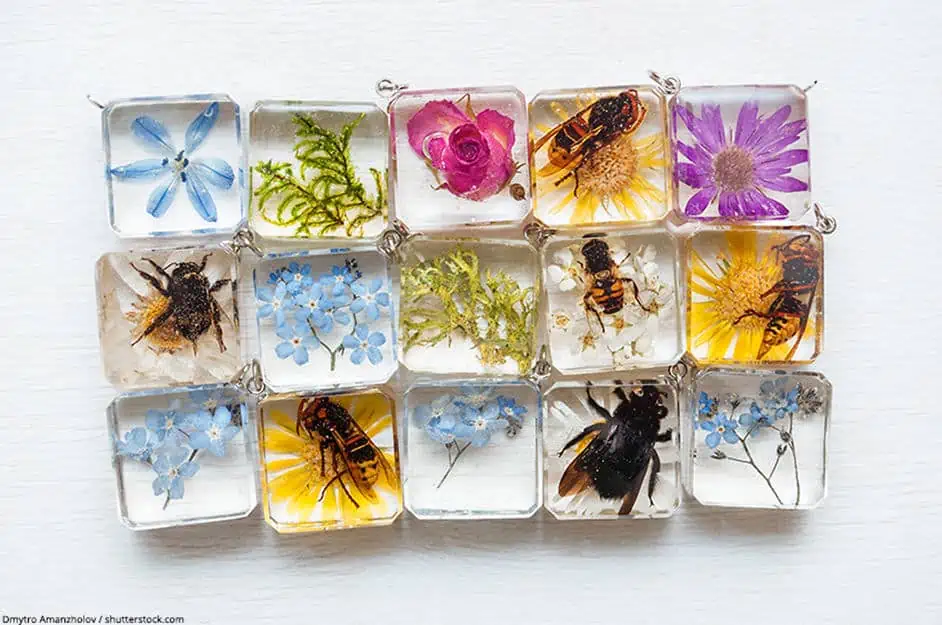
Roses in Clear Resin
Roses are such beautiful flowers and it is a shame to see them go to waste after such a short time of enjoyment. So, why not preserve your roses in clear resin, you can then enjoy them for many more years to come.
Here are 3 steps for you to follow to make this exciting project a reality:
Dry your Roses
- Choose the roses you want to embed and make sure you pick or buy them before they fully bloom. This helps to retain the vibrant color.
- Remove most of the leaves from the stem and the few remaining leaves will add a nice touch to your design when it is finished.
- Take a piece of string and wrap it around the stem of the roses a few times. Make sure you tie them tightly so they do not come loose.
- Take the bunch of roses and hang them up to dry, and make sure they are not directly in the sun. They should take around 7 to 15 days to dry properly. You need to keep a check on them every 2 to 3 days to see they are drying properly.
- Once they are fully dried remove them from the bunch and cut the rose from the stem. If you want to use any of the leaves in your design, remove them from the stem and when you arrange the flowers in the resin you can set them how you want to.
- To do the final drying you can use a conventional oven set at 100° F (38° C) for 2 to 3 hours. Lay the roses out on a baking sheet and put them into the oven on the lowest rack.
- You can also use a microwave oven to do the final drying, which saves a lot of time as it can be done within 2 or 3 minutes. However, for this, you need to put the roses into silicon sand or gel first. After removing from the microwave, allow to stand for 24 hours before you use them.
Prepare the Resin
- It is suggested that you use some clear polyester casting resin if you want to see your rose clearly once it has cured. This type of resin is also much slower in drying, which gives you more time to properly arrange your flowers.
- If you want a tinted finish, you should use epoxy resin. This type of resin cures faster but it also lasts longer than polyester resin.
- Before you cast your resin, be sure to work in a well-ventilated area and use protective wear such as nitrile gloves, goggles and a respirator or mask.
- Choose the mold you want, which can be plastic but silicon or latex-rubber is better. These are more flexible when having to remove your mold. Measure the amount of resin you need for your mold, follow the manufactures instructions.
- Pour the resin into your mixing cup and add the hardener, this is usually a mixing ratio of 1:1.
- Stir the solution properly with a craft or popsicle stick for at least 1 minute, making sure it is properly mixed.
Create your Mold Item
- Pour your first layer of mixed resin into the mold.
- Next, lay your rose on top of the resin and arrange it as you want, including the leaves.
- Pour the remaining resin over the rose until it is completely covered. If the roses rise slightly that is ok.
- Now, wait for about 10 to 20 minutes and check if the resin has started to set but still pliable. Push your rose further into the resin if it floated up until it is in the position you want.
- Let the resin cure for around 4 hours or until you feel it is hard. If it is still sticky leave a little longer to cure.
- Remove your rose from the mold. If you used the correct type of mold you will have little or no finishing to do. Leave to cure properly for a further 24 to 48 hours.
With this type of process, you will be able to preserve your rose for a long time in the form of a paperweight or any other type of project you can think of.
Take a look at our resin flower preservation webstory here!
Jane Lenahan is a resin artist and lives together with her daughter and fiancé in Wales, UK. She works as a carer for the elderly, which is challenging but also extremely rewarding. Sometimes it is not easy to reconcile her job, family, and her resin art. Jane describes herself as a daydreamer, who loves quotes, whimsical worlds, and loves being outdoors in nature. Another of her great hobbies is knitting. Jane tries to incorporate all this into her art. Her great passion and trademark are her unmistakable “botanical pieces” made of resin. Jane runs her online shop Maia and the Wildflower, where you can buy her unique objects and jewelry made of resin.
Learn more about Jane Lenahan.
